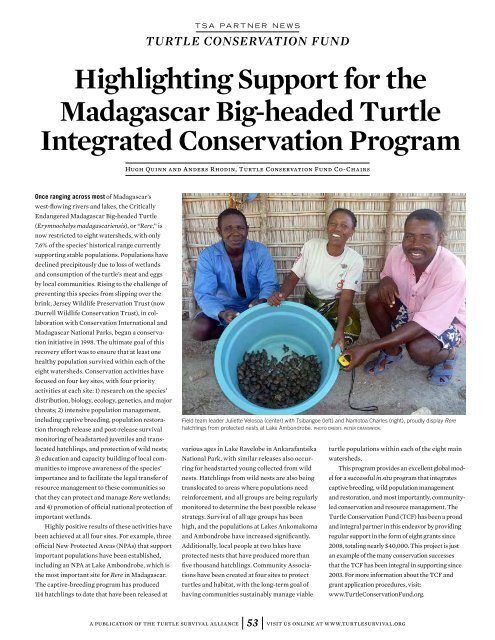Turtle Survival
2tUaeTbNi
2tUaeTbNi
Create successful ePaper yourself
Turn your PDF publications into a flip-book with our unique Google optimized e-Paper software.
TSA PARTNER NEWS<br />
TURTLE CONSERVATION FUND<br />
Highlighting Support for the<br />
Madagascar Big-headed <strong>Turtle</strong><br />
Integrated Conservation Program<br />
Hugh Quinn and Anders Rhodin, <strong>Turtle</strong> Conservation Fund Co-Chairs<br />
Once ranging across most of Madagascar’s<br />
west-flowing rivers and lakes, the Critically<br />
Endangered Madagascar Big-headed <strong>Turtle</strong><br />
(Erymnochelys madagascariensis), or “Rere,” is<br />
now restricted to eight watersheds, with only<br />
7.6% of the species’ historical range currently<br />
supporting stable populations. Populations have<br />
declined precipitously due to loss of wetlands<br />
and consumption of the turtle’s meat and eggs<br />
by local communities. Rising to the challenge of<br />
preventing this species from slipping over the<br />
brink, Jersey Wildlife Preservation Trust (now<br />
Durrell Wildlife Conservation Trust), in collaboration<br />
with Conservation International and<br />
Madagascar National Parks, began a conservation<br />
initiative in 1998. The ultimate goal of this<br />
recovery effort was to ensure that at least one<br />
healthy population survived within each of the<br />
eight watersheds. Conservation activities have<br />
focused on four key sites, with four priority<br />
activities at each site: 1) research on the species’<br />
distribution, biology, ecology, genetics, and major<br />
threats; 2) intensive population management,<br />
including captive breeding, population restoration<br />
through release and post-release survival<br />
monitoring of headstarted juveniles and translocated<br />
hatchlings, and protection of wild nests;<br />
3) education and capacity building of local communities<br />
to improve awareness of the species’<br />
importance and to facilitate the legal transfer of<br />
resource management to these communities so<br />
that they can protect and manage Rere wetlands;<br />
and 4) promotion of official national protection of<br />
important wetlands.<br />
Highly positive results of these activities have<br />
been achieved at all four sites. For example, three<br />
official New Protected Areas (NPAs) that support<br />
important populations have been established,<br />
including an NPA at Lake Ambondrobe, which is<br />
the most important site for Rere in Madagascar.<br />
The captive-breeding program has produced<br />
114 hatchlings to date that have been released at<br />
Field team leader Juliette Velosoa (center) with Tsibangoe (left) and Namotoa Charles (right), proudly display Rere<br />
hatchlings from protected nests at Lake Ambondrobe. PHOTO CREDIT: PETER CRANSWICK.<br />
various ages in Lake Ravelobe in Ankarafantsika<br />
National Park, with similar releases also occurring<br />
for headstarted young collected from wild<br />
nests. Hatchlings from wild nests are also being<br />
translocated to areas where populations need<br />
reinforcement, and all groups are being regularly<br />
monitored to determine the best possible release<br />
strategy. <strong>Survival</strong> of all age groups has been<br />
high, and the populations at Lakes Ankomakoma<br />
and Ambondrobe have increased significantly.<br />
Additionally, local people at two lakes have<br />
protected nests that have produced more than<br />
five thousand hatchlings. Community Associations<br />
have been created at four sites to protect<br />
turtles and habitat, with the long-term goal of<br />
having communities sustainably manage viable<br />
turtle populations within each of the eight main<br />
watersheds.<br />
This program provides an excellent global model<br />
for a successful in situ program that integrates<br />
captive breeding, wild population management<br />
and restoration, and most importantly, communityled<br />
conservation and resource management. The<br />
<strong>Turtle</strong> Conservation Fund (TCF) has been a proud<br />
and integral partner in this endeavor by providing<br />
regular support in the form of eight grants since<br />
2008, totaling nearly $40,000. This project is just<br />
an example of the many conservation successes<br />
that the TCF has been integral in supporting since<br />
2003. For more information about the TCF and<br />
grant application procedures, visit:<br />
www.<strong>Turtle</strong>ConservationFund.org.<br />
a publication of the turtle survival alliance 53 visit us online at www.turtlesurvival.org


